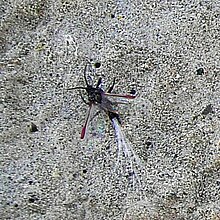
Back Porphyrophora hamelii Byelorussian Porphyrophora hamelii CEB Armenian cochineal DAG Որդան կարմիր Armenian Որդան Կարմիր HYW Porphyrophora hamelii Italian Араратская кошениль Russian Porphyrophora hamelii Swedish Porphyrophora hamelii Turkish Porphyrophora hamelii WAR
| Armenian cochineal | |
|---|---|

| |
| Porphyrophora hamelii (female) | |

| |
| Porphyrophora hamelii (male) | |
| Scientific classification | |
| Domain: | Eukaryota |
| Kingdom: | Animalia |
| Phylum: | Arthropoda |
| Class: | Insecta |
| Order: | Hemiptera |
| Suborder: | Sternorrhyncha |
| Family: | Margarodidae |
| Genus: | Porphyrophora |
| Species: | P. hamelii
|
| Binomial name | |
| Porphyrophora hamelii Brandt, 1833
| |
| Synonyms [1] | |
The Armenian cochineal (Porphyrophora hamelii), also known as the Ararat cochineal or Ararat scale, is a scale insect indigenous to the Ararat plain and Aras (Araks) River valley in the Armenian Highlands, including East of Turkey. It was formerly used to produce an eponymous crimson carmine dyestuff known in Armenia as vordan karmir (Armenian: որդան կարմիր, literally "worm's red") and historically in Persia as kirmiz.[1][2][3][4][5][6] The species is critically endangered within Armenia.[7]
The Armenian cochineal scale insect, Porphyrophora hamelii, is in a different taxonomic family from the cochineal found in the Americas. Both insects produce red dyestuffs that are also commonly called cochineal.[8]
- ^ a b Ben-Dov, Y.; Miller, D.R.; Gibson, G.A.P. (9 October 2014). "ScaleNet, Porphyrophora hamelii". ScaleNet. Archived from the original on 25 October 2014. Retrieved 8 October 2014.
- ^ Ben-Dov, Yair (2005). A Systematic Catalogue of the Scale Insect Family Magarodidae (Hemiptera: Coccoidea) of the World. United Kingdom: Intercept (Lavoisier). ISBN 978-1-84585-000-5.
- ^ Forbes, R.J. (1964) [1956]. Studies in Ancient Technology. Vol. IV (2nd ed.). Leiden, Netherlands: E.J. Brill. pp. 102–103. ISBN 90-04-08307-3.
- ^ Donkin, R.A. (1977). "The Insect Dyes of Western and West-Central Asia". Anthropos. 72 (5/6). Anthropos Institute: 847–880. JSTOR 40459185.
- ^ Vedeler, Marianne (2014). Silk for the Vikings. Oxford, United Kingdom: OXBOW BOOKS. p. 52. ISBN 978-1-78297-215-0. Vedeler, citing Cardon (2007), notes that "the Persian name Kirmiz originally referred to the Armenian carmine, a parasitic insect living on Gramineae grass, but the same name was also used by Arab geographers for insects living on oak trees in Maghreb and Al-Andalus, probably referring to Kermes vermilio", although "[i]t is ... not clear whether the 'Kirmiz' dyestuff mentioned in early Arab texts always refers to the use of the insect Kermes Vermilio."
- ^ Cardon, Dominique (2007). Natural Dyes: Sources, Tradition, Technology and Science. London, United Kingdom: Archetype Books. ISBN 978-1-904982-00-5. English translation by Caroline Higgitt of Cardon's French-language book Le monde des teintures naturelles (Éditions Belin, Paris, 2003).
- ^ Khachatryan, H. "Porphyrophora ham melii Brandt, 1833". Red Book of Armenia. Republic of Armenia Ministry of Environment. Retrieved 9 October 2014.
- ^ Eastaugh, Nicholas; Walsh, Valentine; Chaplin, Tracey; Siddall, Ruth (2004). Pigment Compendium: A Dictionary of Historical Pigments. Oxford, UK and Burlington, MA: Elsevier Butterwoth-Heinemann. pp. 118–119. ISBN 0-7506-5749-9. Retrieved 4 December 2015.